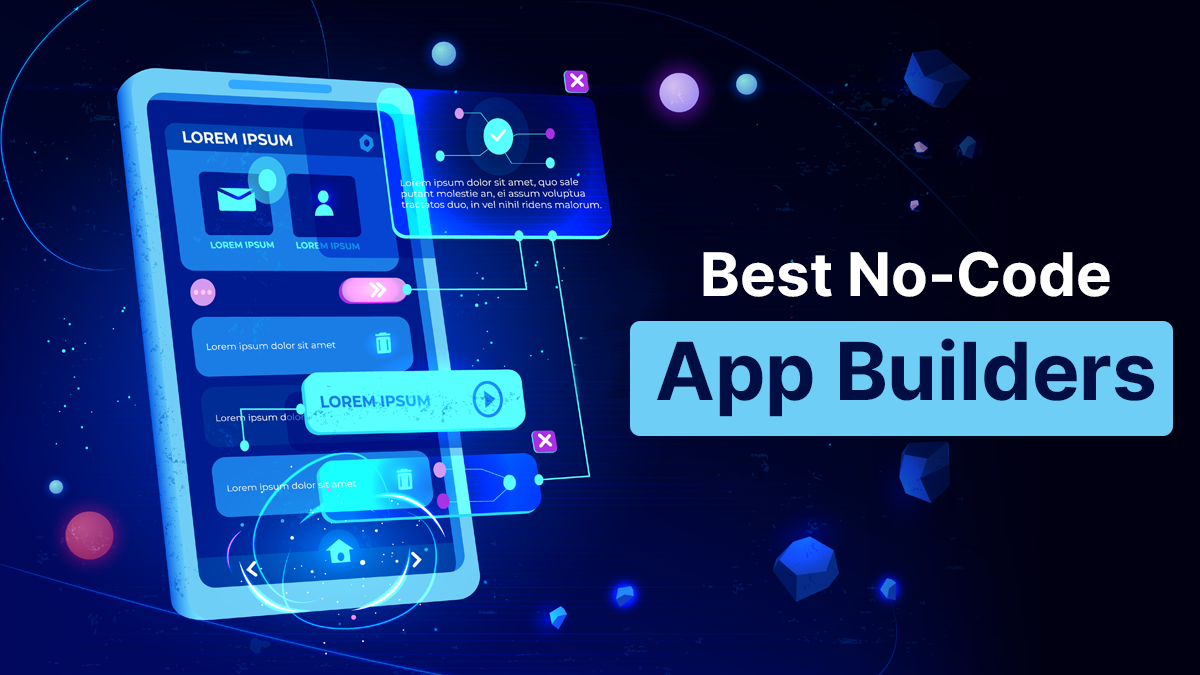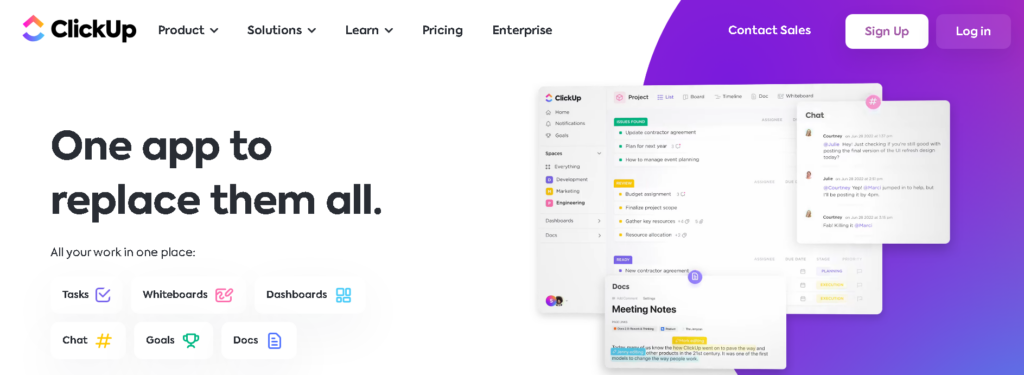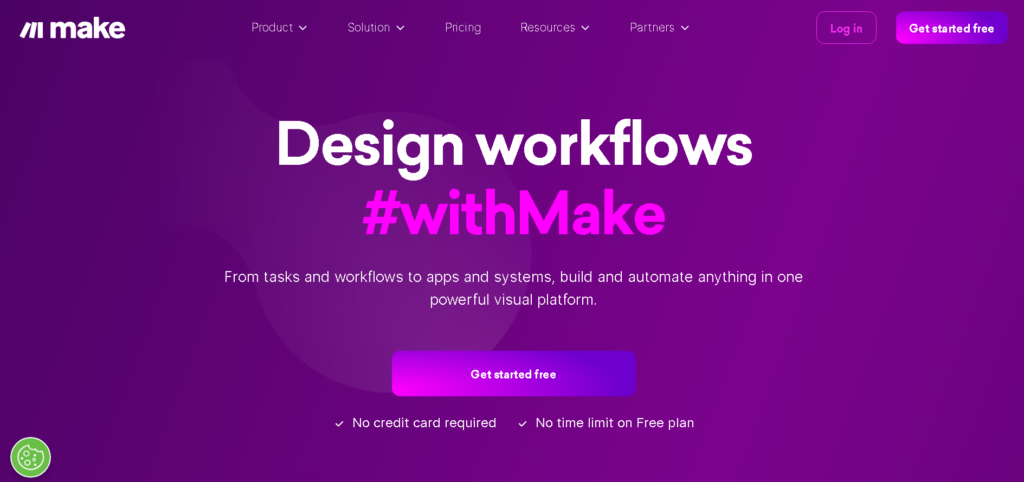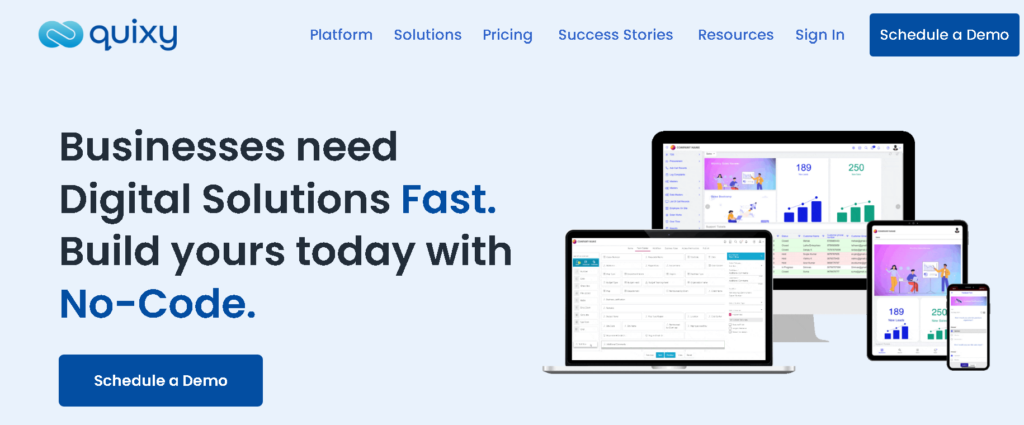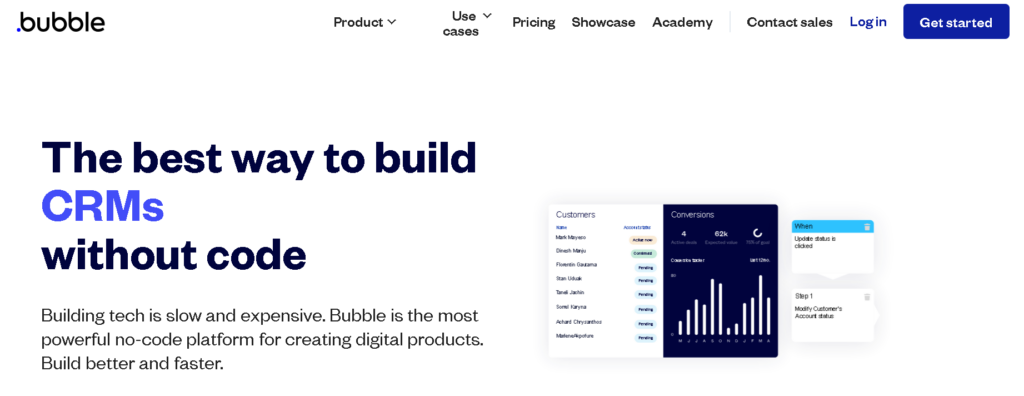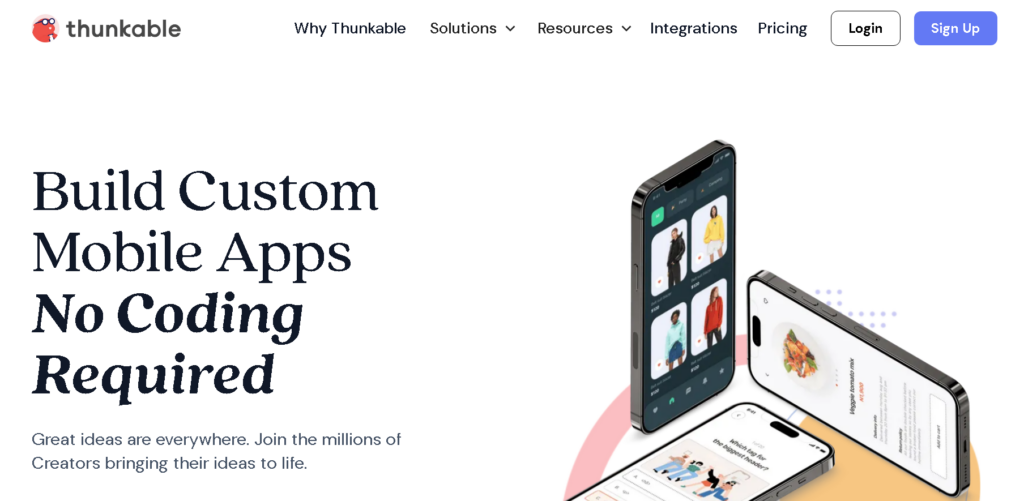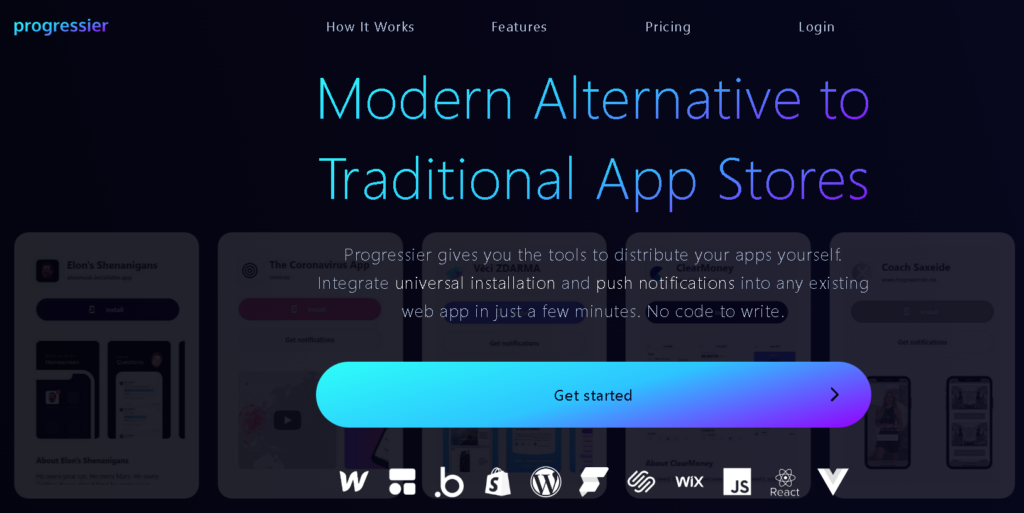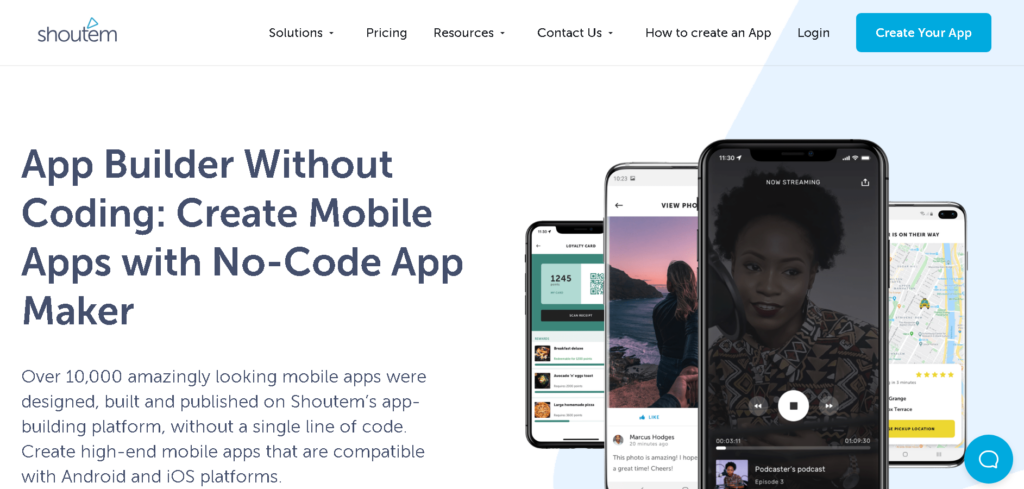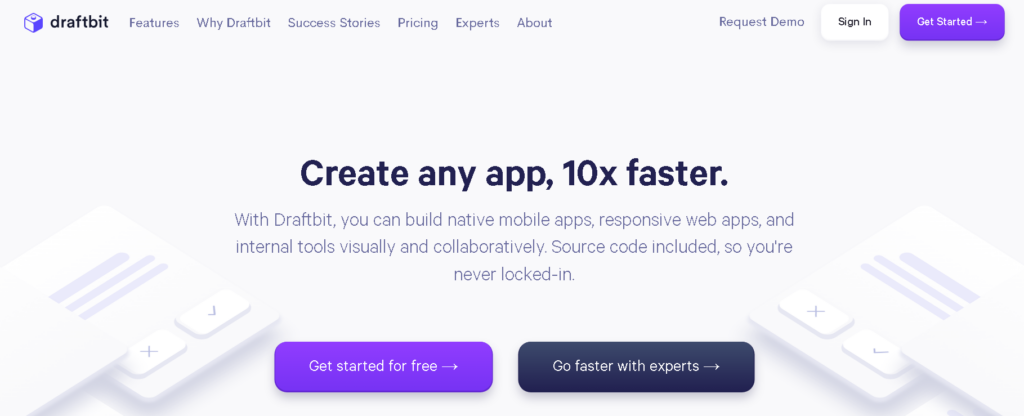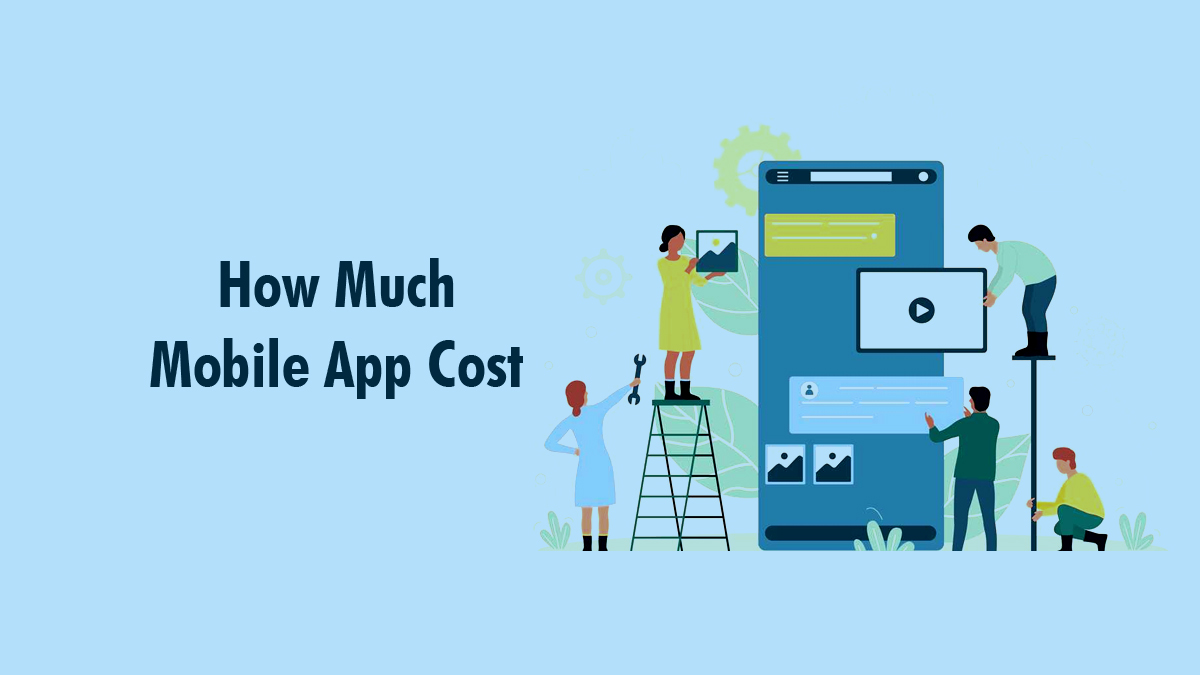No-code app builders have made a significant impact over the past decade, empowering tech enthusiasts to create apps without requiring extensive coding knowledge. These platforms offer a user-friendly experience, often using visual interfaces in lieu of complex programming commands.
The Result: You can develop business applications, launch websites, optimize processes, and much more, all without any coding know-how. No-code platforms excel when backed by your creativity and a robust builder to materialize your ideas. Here are the best no-code app builders for quickly developing reliable and high-quality applications.
What Does a No-Code App Builder Mean?
A no-code app builder allows users to create and deploy applications without traditional programming skills. These platforms offer drag-and-drop features and pre-designed templates, making it easier for users to build their own software. No-code app development democratizes the process, enabling people without coding experience to produce a variety of digital solutions like websites, mobile apps, tools, and dashboards.
Mobile app development experts often recommend no-code app builders because they dramatically reduce the time and cost associated with app development, allowing for rapid prototyping and iterative design without the need for specialized coding skills.
These platforms empower businesses to take control of their app creation, fostering innovation and agility by making app development accessible to a broader range of creators, including those without technical backgrounds.
What Features Should You Consider in a No-Code App Builder?
Choosing the right no-code platform can be challenging. Here are some key attributes to consider:
Easy to use: A no-code app should be intuitive, negating the need for programming. Top platforms in this space feature an interface that allows for straightforward clicking and dragging of components to assemble the desired application.
Customizability: A good no-code platform offers ample options for personalization, adapting to the needs of different industries and user groups. It should also permit the incorporation of your unique branding elements.
Functionality: The platform should offer an array of tools, including forms, templates, and visualizations, to expedite your development process.
Integrations: Compatibility with established project management, collaboration, and CRM platforms is essential for seamless workflow.
Scalability: As your business grows, the platform should be capable of accommodating a larger user base and more complex tasks.
Advantages of No-Code App Builders
No-code app builders offer a streamlined way for businesses to create applications without the need for specialized coding skills. This democratizes the app development process, eliminating the need to hire a team of software engineers for most projects. Below are some of the key advantages of using no-code app builders.
Perfect for Beginners
No-code platforms are perfect for those who have little to no coding experience. You can build a functional and professional-looking application without delving into the complexities of programming.
Time Efficient
While a basic understanding of technology can be beneficial, it’s not a prerequisite for using a no-code app builder. These platforms often offer drag-and-drop functionality and pre-designed templates, enabling you to build your app more quickly than traditional methods would allow.
Affordable Cost
No-code platforms often eliminate the need to hire a dedicated development team, which can be a significant cost-saving factor. Prices for using these builders can vary, typically ranging from $15 to $500 per month, depending on the features and services offered.
Free Until Going Live
Many no-code platforms offer free versions that allow you to explore their functionalities. This enables you to get a feel for the platform and its capabilities before committing financially, making it a low-risk option for those starting out.
Works Across Platforms
There’s generally no need to choose between Android and iOS when building an app on a no-code platform. Most of these platforms enable you to publish your app across multiple operating systems, and some even offer web-based or mobile-responsive versions to maximize your reach.
Top 12 No-Code App Builders
Understanding the difference between no-code and low-code platforms is essential. While low-code platforms minimize coding but still require some developer involvement, no-code platforms eliminate the need for coding altogether, offering a more cost-effective mobile app development solution.
We’ve compiled a list of the top 12 no-code app builders that offer effective solutions at varying price points. Read on to explore the features, advantages, and disadvantages of each, and find the best fit for your needs.
ClickUp
ClickUp is an excellent tool for project management, team collaboration, and overall efficiency. It caters to a broad audience—individuals working alone, freelancers, large corporations, and everything in between. The platform is highly customizable, allowing users to tweak and automate the system according to their unique requirements.
“ClickUp views” offer multiple ways to organize and display information. You can manage your API workflow in ClickUp through more than 15 different views, customizing the platform by simply dragging and dropping elements.
The platform is especially useful for organizing tasks, managing resources, monitoring QA testing, overseeing development, and executing marketing strategies. ClickUp’s drag-and-drop feature enables users to access even the most complex functionalities without any coding knowledge.
As an admin, you can enhance your workspace by utilizing ClickApps and the ClickUp API. These tools allow you to personalize your workspace visually, integrate internal applications for work management, and even generate reports all within a single platform. Additionally, ClickUp AI can assist with idea generation and communication planning, while the Automation feature simplifies repetitive tasks. Notable ClickApps include:
- Sprints
- Custom Fields
- Collaborative Editing
- Task Dependencies
- Custom Task IDs
ClickUp’s API support lets you integrate it with over 1,000 other tools, making task management and time tracking seamless, even outside the ClickUp environment. Furthermore, you can take advantage of ClickUp’s ready-made templates for web pages, landing pages, bug reports, product launches, and graphic designs.
Features
- Build internal software using ClickApps
- Automate complicated tasks
- Highly scalable
- Diverse template options
- Integrate with over 1,000 systems through the ClickUp API
- Drag-and-drop interface
Disadvantages
- Workspace customization can be time-consuming
- Some users desire more automation features
Pricing
- Free tier available
- Unlimited: $7/user/month
- Business: $12/user/month
- Enterprise: Contact for pricing details
- Additional $5 per workspace member per month for ClickUp AI features
Ratings
- G2: 4.7 out of 5 based on over 6,500 reviews
- Capterra: 4.7 out of 5 based on over 3,500 reviews
Also Read: What is a Framework in Programming: The Key to Efficient Coding
Make (Integromat)
Make, previously branded as Integromat, is a platform designed to simplify the automation of workflows for your app ideas—no coding required. It offers an intuitive design that streamlines the development of effective solutions, enhancing both individual productivity and team collaboration. With Make, you can create applications that cater to various departments within your organization, such as:
- Marketing: Accelerates lead generation for more efficient conversions
- Sales: Manages contracts and enhances customer support
- Operations: Focuses on collecting and organizing daily activities and data
- IT: Identifies and mitigates potential security risks to reduce vulnerability to attacks
- Human Resources: Facilitates a smoother onboarding process for new hires
When integrated with ClickUp, Make becomes a powerful tool for automating complex tasks across various applications. This synergy enables you to effortlessly connect ClickUp with other online tools and APIs, streamlining your processes even if you lack programming skills. Additionally, Make provides an array of ready-to-use templates to help you automate tasks effortlessly.
Features
- Supports multi-departmental workflows
- Aids in demystifying complex procedures
- Features an intuitive drag-and-drop builder
- Offers straightforward templates for task automation
- Seamlessly integrates with ClickUp
Disadvantages
- API documentation could be more comprehensive
- There may be a learning curve to fully grasp all available features
Pricing
- Free tier available
- Core: $9/month for 10,000 operations
- Pro: $16/month for 10,000 operations
- Teams: $29/month for 10,000 operations
- Enterprise: Contact for pricing details
Ratings
- G2: 4.7 out of 5 based on over 150 reviews
- Capterra: 4.8 out of 5 based on over 300 reviews
Quixy
Quixy is a no-code platform designed to empower you to develop robust software solutions without writing a single line of code. It specializes in automating intricate tasks across business operations, allowing you to create customized apps at a pace much faster than traditional coding methods. With its drag-and-drop interface and extensive library of pre-made building blocks, Quixy enables you to effortlessly design apps tailored to any business or industry.
Start your application from scratch or leverage Quixy’s pre-designed templates for specialized tasks to enhance organization and precision. Below are some areas where Quixy can be applied across five key departments:
Help desk support: Automates customer service requests and complaints
Project management: Streamlines task monitoring, planning, and meeting scheduling
Customer relationship management: Facilitates automated communication with current and prospective customers
Managing travel and expense costs: Simplifies the tracking of office and travel expenditures
Employee performance management: Monitors employee punctuality and performance metrics
Features
- Enables the development of sophisticated business applications without the need for programming expertise
- Robust security protocols to minimize the risk of unauthorized data access
- Cross-departmental automation capabilities
- Exceptional customer support
Disadvantages
- The user interface and experience leave room for improvement
- Lacks comprehensive guidance and documentation, especially in comparison to other user-friendly platforms
Pricing
- Solution: Contact for pricing details
- Platform: $20/month per user (minimum of 20 users required)
- Enterprise: Contact for pricing details
Ratings
- G2: 5 out of 5 based on over 100 reviews
- Capterra: 4.7 out of 5 based on over 20 reviews
Glide
Elevate your data by transforming it into functional apps with Glide. Easily import information from Google Sheets, Excel, or Glide Tables. With just a simple drag-and-drop of images or videos, you can convert dull spreadsheets into dynamic apps compatible with any device. Glide is highly customizable, compatible with various software, and offers a variety of pre-made templates, making the transition from spreadsheet to app a seamless experience.
Worried about your app appearing dated? Glide automatically updates your app’s aesthetics to align with the latest industry trends. It’s an ideal platform for beginners or those looking for a straightforward app creation experience. However, it may not be the best fit for those aiming to develop apps with intricate features.
Features
- User-friendly drag-and-drop interface
- Extensive customization options, including pre-designed layouts and features
- Rapid app deployment
- Comprehensive support resources
- Auto-adjusting visuals ensure your app looks stellar on all devices
Disadvantages
- Room for improvement in the UI editor
- The platform can be confusing at times, and technical support is not always readily available
Pricing
- Free: $0 per month
- Starter: $25 per month
- Pro: $99 per month
- Business: $249 per month
- Enterprise: Contact for pricing details
Ratings
- G2: 4.7 out of 5 based on over 350 reviews
- Capterra: 4.7 out of 5 based on over 50 reviews
Softr
Softr is a no-code platform that simplifies app creation by allowing you to integrate data from Airtable or Google Sheets. Designed for ease of use, Softr features a straightforward interface that eliminates the need for complex tutorials.
Build your apps and websites incrementally with Softr’s versatile toolkit. The left-hand side of the interface houses essential settings, from user management controls to theme selection. The central workspace serves as your canvas, where you can place either fixed or dynamic building blocks to create your app.
Softr provides customizable templates and editing features, making it easy to create professional-looking and functional apps. However, it’s worth noting that Softr may not be suitable for more complex app development needs, such as forms that require conditional logic.
Features
- Seamless integration with Google Sheets and Airtable
- User-friendly interface
- Client portal templates
- Generous offerings on the free tier
Disadvantages
- Some design elements may not function as expected
- Limited feature set for advanced needs
Pricing
- Free: $0 per month
- Basic: $49 per month
- Professional: $139 per month
- Business: $269 per month
- Enterprise: Contact for pricing details
Ratings
- G2: 4.8 out of 5 based on over 200 reviews
- Capterra: 4.7 out of 5 based on over 50 reviews
Bubble
Bubble is an excellent choice for both prototyping and fully-fledged app development. Popular among app development agencies, Bubble speeds up the process of delivering client projects. If you’re comfortable using Excel or Canva, you’ll find the platform’s interface intuitive. Bubble offers a drag-and-drop editor, making customization a breeze.
The platform boasts an active community, providing access to over 1,200 pre-made templates for various business sectors like real estate and food delivery. This can help you accelerate your app-building process. Bubble also integrates seamlessly with a multitude of other apps and tools, centralizing your work in one hub. While the platform is easy to learn, any difficulties you face can be addressed by the supportive Bubble community.
Features
- Intuitive interface, especially for those familiar with Excel or Canva
- Strong community support
- Diverse industry-specific templates are available
- A broad range of integrations
Disadvantages
- Recent pricing changes have raised concerns among long-term users
- Performance can sometimes be sluggish
Pricing
- Free: $0 per month
- Starter: $29 per month
- Growth: $119 per month
- Team: $349 per month
- Custom: Contact for pricing details
Ratings
- G2: 4.4 out of 5, based on over 100 reviews
- Capterra: 4.6 out of 5, based on over 250 reviews
Thunkable
Experience hassle-free app development with Thunkable. Designed for those who prefer not to code, this platform allows you to launch high-quality apps quickly. With its intuitive drag-and-drop interface and pre-made components, you can tailor your app to meet specific customer needs.
While Thunkable is marketed as a no-code platform, some users find it to be more of a low-code solution. This is because a basic understanding of logic operations is beneficial for effective use. The platform may not be the best fit for complex enterprise apps due to its limited advanced features. However, it’s an excellent option for developing simplified products or prototypes for investor presentations.
Features
- Quick and straightforward mobile app development
- A variety of pre-made components
- Simultaneous publishing to both iOS and Android
- Customizable media additions
- Free access is available at the Personal tier
Disadvantages
- The database designer’s layout may be confusing for some
- Value for price is a concern for some users
Pricing (Business tier)
- Business: $200 per month
- Teams: $500 per month
- Custom: Contact for pricing details
Ratings
- G2: 4.4 out of 5, based on over 30 reviews
- Capterra: 4.5 out of 5, based on four reviews
Progressier
Progressier is an invaluable tool for building progressive web apps (PWAs), essentially websites that function like mobile apps. A valuable addition to your no-code arsenal, these PWAs are developed using HTML, CSS, and JavaScript. They offer the same features as native apps but are more responsive. Progressier provides you with an array of tools for PWA development, such as:
- PWA dashboard
- iOS splash screens
- Reviews for apps are all in one place
- Screenshot designer
- No-code web app manifest
The platform is user-friendly and compatible with various no-code app builders. Plus, Progressier offers excellent technical support, ensuring that any issues you encounter are quickly resolved.
Features
- Converts no-code apps into PWAs
- Compatible with app builders like Softr, Webflow, and Bubble
- User-friendly dashboard with a clean and organized layout
- Ideal for beginners
- 14-day free trial available
Disadvantages
- Lacks device-specific notifications and offline network caching features
- Limited features for Apple device users
Pricing
- Founder: $15 per month
- Growth: $39 per month
- Scale: $149 per month
Ratings
- G2: Not available
- Capterra: 5 out of 5, based on five reviews
Shoutem
Shoutem offers an intuitive interface that simplifies the app development process. With its drag-and-drop feature, you can easily create and connect various elements. The platform also includes a preview option, allowing you to test the app’s functionality and appearance on multiple devices before publishing.
Shoutem’s analytics tools provide valuable insights into user behavior, issues encountered, and visitor numbers. This data can be leveraged to make informed decisions for improving your app. You can also incorporate special loyalty programs to engage high-spending customer groups. Highlights of the platform include:
- Integrations with WordPress, Shopify, and social media platforms
- Audio and video modules
- Unlimited notifications to users
Features
- User-friendly features for straightforward mobile app development
- Useful integrations for customer engagement
- Security enhancements
- Real-time updates to improve user experience, including push notifications, feed updates, and live streaming
Disadvantages
- Customer support could be more responsive
- Even the most expensive plan only offers 10 GB of space
Pricing
- Android: $49 per month
- Standard: $79 per month
- Professional: $149 per month
Ratings
- G2: 3.7 out of 5, based on five reviews
- Capterra: 3.8 out of 5, based on 12 reviews
Gappsy
Gappsy provides an intuitive platform for teams to build web apps without the need for coding expertise or IT support. The platform streamlines the mobile app development process into four straightforward steps, eliminating the complexity often associated with other platforms:
Step 1: Buy the lifetime deal
Step 2: Design your own layout (pick from over 100 pre-made designs)
Step 3: Include the features you want
Step 4: Publish your final product
You can customize the app’s functionality to align with its intended purpose and improve user experience. Additionally, you can connect the app to your social media accounts to increase visibility and promote your products or services.
Gappsy also offers specialized services for business apps, including AI, analytics, and lead conversion tools. These features can contribute to enhancing your revenue streams. Apps developed using this platform generally comply with Google Play and Apple Store guidelines upon release.
Features
- One-time fee for lifetime access
- Simple and organized design interface
- Direct app publishing capability
- Availability of AI and analytics tools
Disadvantages
- Some users report difficulty in contacting technical support
- Limited tutorials, making it challenging for newcomers to get started
Pricing (Lifetime)
- Basic: $87
- Pro: $167
- Business: $287
Ratings
- G2: N/A
- Capterra: N/A
Draftbit
Draftbit offers the unique advantage of transitioning from a no-code to a pro-code environment as your app gains traction. If your app becomes highly successful and requires more advanced features, Draftbit allows you to upgrade to a monthly subscription and employ their team of experts to handle the development. This enables you to concentrate on other aspects like product design, marketing, and business expansion.
Draftbit sets itself apart by allowing you to create and manage device-specific variables, a feature not commonly found in other no-code platforms. These variables help optimize your app’s performance on various devices by tracking attributes like app settings, screen dimensions, and device type. This not only enhances the app’s functionality but also contributes to keeping user data private.
Features
- Ability to create device-specific mobile apps
- Multiple data connection options for diverse sources
Disadvantage
- Although possible, web app creation is not as streamlined as with other platforms
Pricing
- Free
- Basic: $19 per month
- Pro: $59 per month
- Team: $199 per month
Ratings
- G2: 5 out of 5 based on one review
- Capterra: 4.2 out of 5 based on 20 review
FlutterFlow
Created by two former Google engineers, FlutterFlow is built on the versatile Flutter framework, making it highly compatible with a range of devices including Android and iOS smartphones, as well as Windows, Mac, and Linux systems.
The platform offers an extensive array of elements to add to your canvas, along with an editor rich in customization options. In the app settings, users can easily integrate functionalities such as social media login and in-app purchases. FlutterFlow also offers pre-designed templates, providing a quick start for those looking to develop feature-rich apps.
For those who prefer not to be confined to a pre-set template, FlutterFlow allows the freedom to explore various screen layouts that can be added as separate pages within your app. If your specific requirements aren’t met by existing templates, the platform’s AI engine comes to the rescue. Simply describe what you’re looking for, and the AI will generate a screen with the essential elements, leaving you to fine-tune the design and functionality.
Features
- Comprehensive control over both design and functionality
- Ease of code addition and modification
Disadvantage
- Steeper learning curve compared to other platforms
Pricing
- Free
- Standard: $30 per month
- Pro: $70 per month
- Teams: $70 per user per month
Ratings
- G2: 4.7 out of 5 based on 15 reviews
- Capterra: 4.5 out of 5 based on 73 reviews
Wrapping Up
No-code app builders are more than just a means to create apps; they are tools that can turn your creative vision into a reality, automate processes, and drive business growth. With user-friendly interfaces, drag-and-drop functionalities, and pre-designed templates, these platforms simplify the road from idea to execution. Browse through our list of recommended no-code app builders, unleash your creativity, and take the first step in turning your business dreams into a reality.
FAQs
Can no-code apps be scaled as my business grows?
Yes, no-code platforms offer scalability to an extent, allowing you to add more features, accommodate more users, and manage increased data as your business evolves. However, if you need a highly specialized solution, you may reach the limits of what a no-code platform can offer. In such cases, you might have to consider custom coding or a low-code platform.
Who can benefit from no-code apps?
No-code platforms are ideal for beginners and those with limited coding knowledge. They’re also useful for developers who wish to integrate diverse technologies quickly. With these tools, the process of iterating based on user feedback can be significantly accelerated, as you won’t have to dig deep into code to make changes.
What is the cost of creating an app?
Developing an app from scratch can be costly, ranging from $15,000 to $300,000 or more. However, no-code platforms can significantly reduce these costs, offering various pricing plans that can range from $15 to $500 per month.
Should I use templates when creating my mobile app?
Most no-code platforms offer a variety of pre-designed templates to help you get started. While you can’t change the underlying code, these templates provide a framework that can be customized—much like writing a blog post—to include your own text, images, and deleted elements to suit your specific needs.

